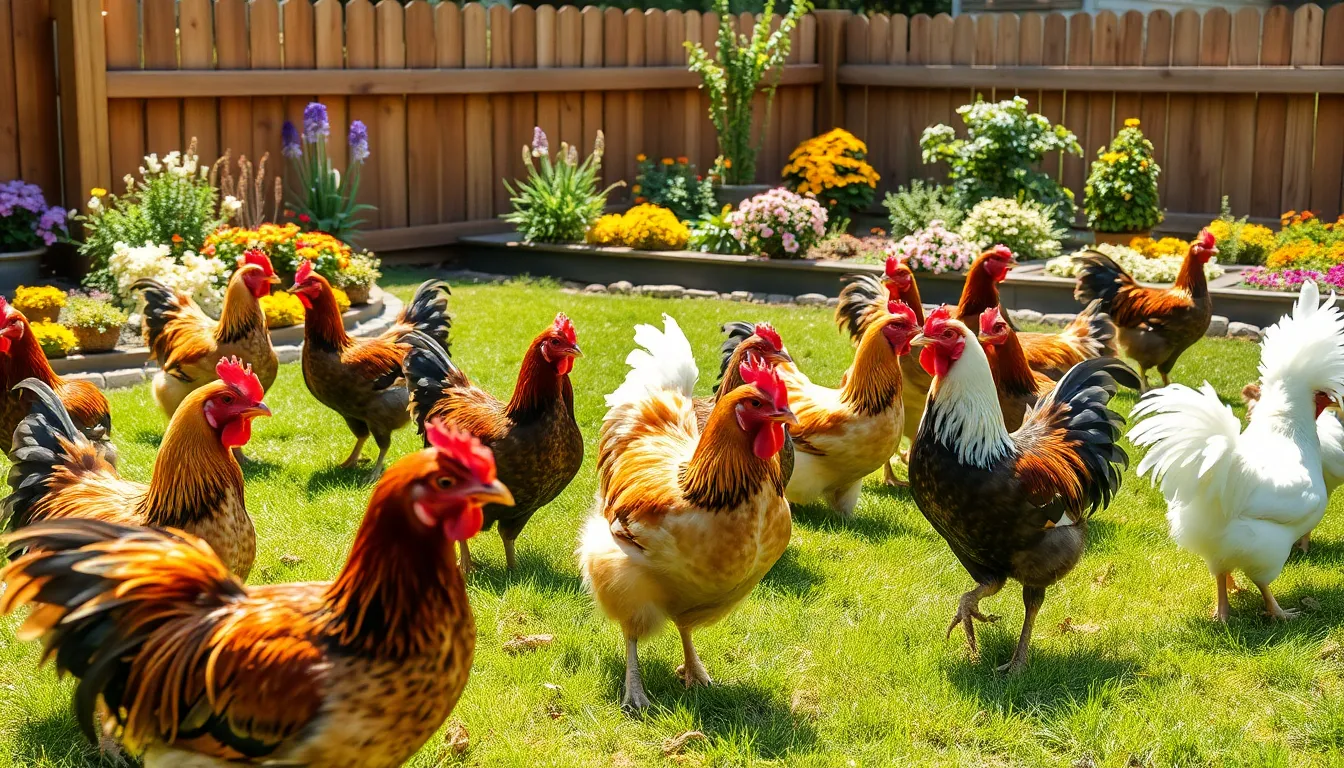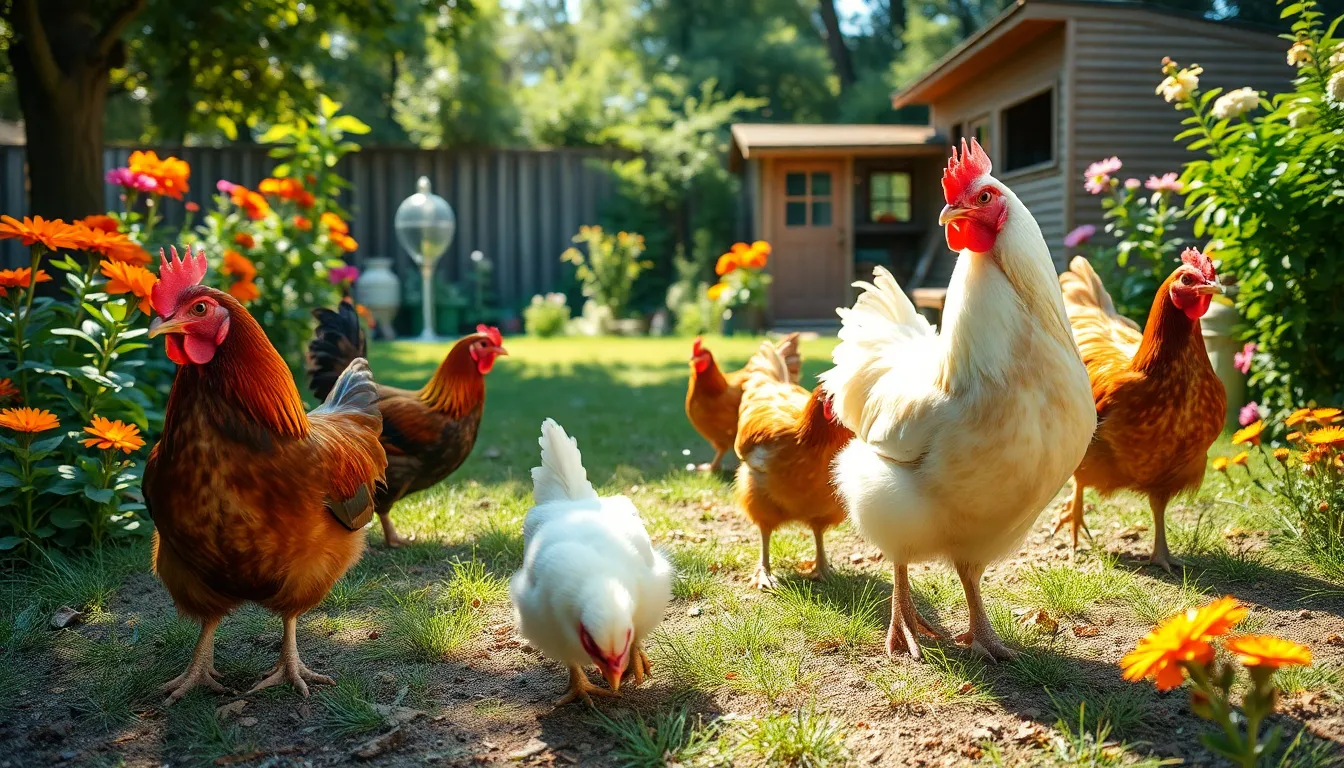Table of Contents
ToggleWhen it comes to backyard chickens, choosing the right breed can feel like dating—everyone has their preferences, and sometimes it’s hard to know who’ll be the best fit. But fear not! Whether you’re dreaming of a feathered friend that lays eggs like a champion or one that struts around with personality, there’s a perfect match waiting for you.
What Are Backyard Chickens?
Backyard chickens refer to domesticated hens kept in residential settings for egg production and companionship. These birds come in various breeds, each showcasing unique characteristics and benefits. Many individuals choose to raise chickens for fresh, organic eggs, contributing to sustainable living.
Chickens are often friendly animals and can develop strong bonds with their owners. They play an integral role in many urban and suburban gardens, helping to control pests while enriching soil with their manure. With proper care, backyard chickens thrive, providing both joy and additional sources of income for their owners.
Egg-laying frequency varies by breed, with some hens producing over 300 eggs annually. The most popular breeds include Rhode Island Reds, known for their hardiness and egg production, and Orpingtons, favored for their friendly disposition and adaptability. Bantam breeds also appeal to those with limited space, as they occupy less area while still providing eggs and companionship.
In addition to egg production, backyard chickens offer educational opportunities for families. Observing chickens teaches children responsibility and promotes understanding of animal care. Many backyard chicken enthusiasts also appreciate the aesthetic value these birds add to their gardens, enhancing overall outdoor spaces.
Social media platforms and community gardens have facilitated a growing interest in raising chickens. This movement highlights the benefits of keeping chickens, from self-sustainability to enhanced family interactions. Consider adopting a flock as a fulfilling and worthwhile endeavor.
Top Breeds of Backyard Chickens

Selecting the ideal breed for backyard chickens enhances enjoyment and productivity. Different breeds serve various purposes, catering to personal preferences and needs.
Dual-Purpose Breeds
Dual-purpose breeds provide both eggs and meat efficiently. Rhode Island Reds excel in laying and produce tender meat. Orpingtons offer a calm demeanor while delivering consistent egg production along with substantial meat. Sussex chickens allow for a balance of both worlds, making them excellent choices for families seeking versatile birds. Maintaining these breeds leads to sustainability and satisfaction.
Egg-Laying Breeds
Egg-laying breeds focus on high production rates. Leghorns stand out for their prolific egg-laying abilities, often producing over 300 eggs per year. It’s common to find Plymouth Rocks among backyard enthusiasts due to their friendly nature and good egg yield. Australorps also deliver impressive production while adapting well to various environments. Choosing these breeds ensures a steady supply of fresh eggs.
Ornamental Breeds
Ornamental breeds capture attention with their striking appearances. Silkies feature fluffy, feathered bodies and friendly personalities. Their charming looks make them popular among families and hobbyists alike. Another attractive option is the Cochin, known for its stunning plumage and gentle temperament. Wyandottes are also admired for their beautiful patterns. Incorporating these breeds adds visual appeal to any backyard space while fostering enjoyment.
Factors to Consider When Choosing Backyard Chickens
Choosing backyard chickens involves several crucial factors that impact their health and productivity. Understanding these elements makes selecting the right breed easier.
Space Requirements
Space requirements significantly influence chicken happiness and egg production. Each chicken needs a minimum of 4 square feet in the coop and 10 square feet in an outdoor run. More space allows chickens to roam, socialize, and exhibit natural behaviors. Backyard space availability determines how many chickens one can raise. For smaller yards, selecting a breed that thrives in confinement, like Bantams, may suit better.
Temperature Tolerance
Temperature tolerance plays a vital role in breed selection. Chickens generally acclimate to various climates, but some breeds excel in specific temperatures. For instance, Brahmas and Orpingtons thrive in colder environments due to their dense feathers. On the other hand, Leghorns perform well in warmer climates, thanks to their active nature and lighter body structure. Knowing the local climate helps determine which breeds withstand extreme weather.
Personality and Temperament
Personality and temperament impact the enjoyment of raising chickens. Friendly, docile breeds like Silkies and Orpingtons are excellent choices for families and first-time chicken keepers. Certain breeds exhibit more assertive behavior, which may not suit every owner. Understanding the interaction level desired with chickens aids in making an informed decision. Some individuals prefer sociable birds that enjoy human companionship, while others might choose more independent breeds for low-maintenance needs.
Caring for Your Backyard Chickens
Caring for backyard chickens involves attention to their feeding, housing, and health. Ensuring their needs are met promotes productivity and well-being.
Feeding and Nutrition
Quality feed forms the foundation of a chicken’s diet. Providing a balanced feed with 16-20% protein supports growth and egg production. Access to fresh fruits, vegetables, and grains enhances their nutrition. Integrating kitchen scraps can reduce waste while adding variety to their meals. Clean, fresh water must always be available to keep chickens hydrated and healthy.
Housing and Shelter
Secure housing protects chickens from predators and inclement weather. A coop requires a minimum of 4 square feet per bird, ensuring they have enough space to move freely. Ventilation prevents moisture buildup, which can lead to respiratory issues. Nesting boxes, one for every 3-4 hens, provide safe spots for laying eggs. An outdoor run of at least 10 square feet per chicken allows for exercise and natural behaviors.
Health and Wellness
Regular health checks identify signs of illness early. Observing activity levels, feather conditions, and droppings helps assess overall health. Vaccination schedules protect against common diseases. Maintaining cleanliness in the coop reduces the risk of pests and parasites. Providing a stress-free environment promotes mental well-being, ensuring happier and healthier chickens.
Choosing the right breed of backyard chickens can transform an ordinary garden into a thriving ecosystem. With options ranging from high egg producers to charming ornamental breeds, there’s a perfect fit for every lifestyle. The joy of raising chickens extends beyond egg production; it’s about companionship and sustainability.
As more people embrace backyard chicken-keeping, they discover the numerous benefits these birds offer, from pest control to enriching family interactions. By prioritizing care and understanding each breed’s unique needs, chicken owners can enjoy a rewarding experience that enhances their home and lifestyle. Embracing the world of backyard chickens is not just a hobby; it’s a fulfilling journey towards self-sufficiency and connection with nature.





